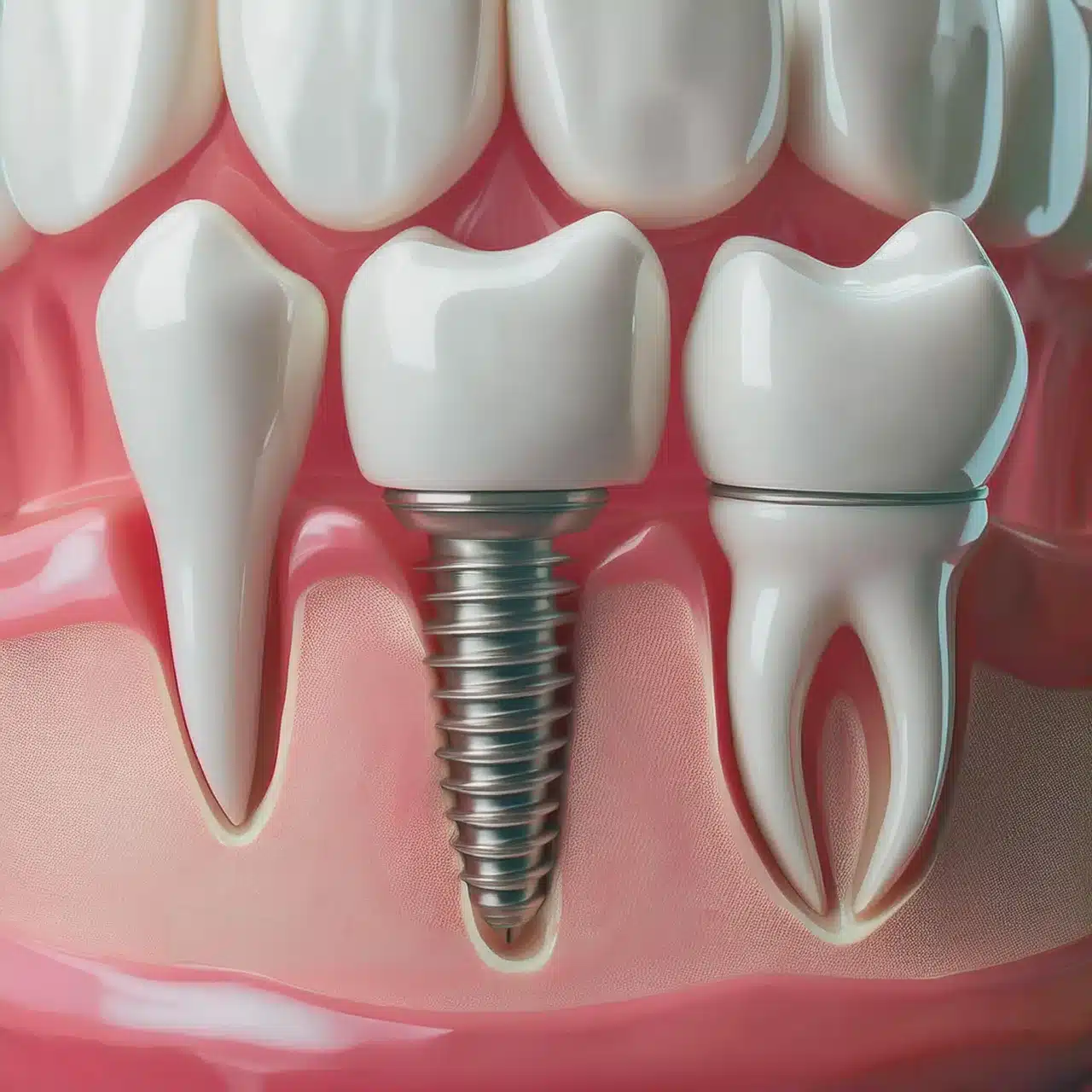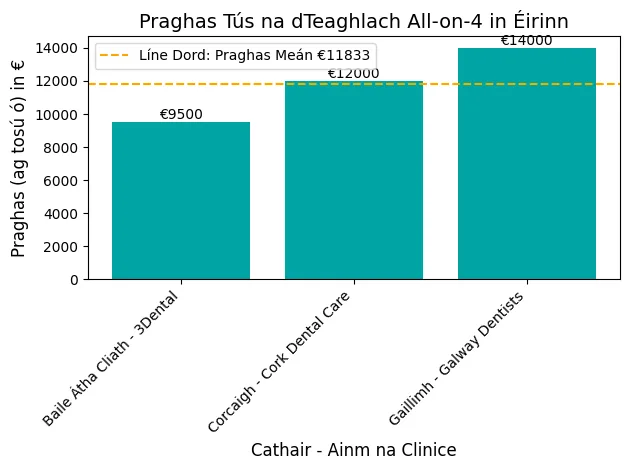Pensate di sostituire i denti mancanti con impianti dentali ma siete preoccupati per le allergie o le complicazioni? Scoprite i pro e i contro per prendere una decisione consapevole sulla vostra bocca.
Che cos'è un'allergia agli impianti dentali?
L'allergia agli impianti dentali è una risposta del sistema immunitario al titanio o ad altri metalli utilizzati negli impianti dentali, che colpisce circa lo 0,6% dei pazienti. Questa condizione può manifestarsi con sintomi quali gonfiore, dolore, eruzioni cutanee, eczema, perdita ossea o fallimento dell'impianto. Sebbene sia rara, si verifica più frequentemente in pazienti con precedenti allergie ai metalli.

Cause di allergia agli impianti dentali
Gli impianti dentali sono generalmente sicuri, ma la comprensione delle cause di allergia è fondamentale per una corretta pianificazione del trattamento.
Materiali utilizzati negli impianti dentali
I materiali utilizzati negli impianti dentali possono causare reazioni allergiche.
Titanio e leghe: Il titanio è ampiamente utilizzato grazie alla sua biocompatibilità, ma alcuni individui possono comunque presentare allergie. Gli studi dimostrano che gli impianti in titanio hanno un'alta percentuale di successo, ma le superfici ruvide possono aumentare il rischio di complicazioni come la perimplantite (1).
Materiali alternativi: Altri materiali come la zirconia e la ceramica sono in fase di studio per le loro proprietà ipoallergeniche. Questi materiali mirano a ridurre il rischio di allergie mantenendo la durata e l'efficacia (2).
Risposta del sistema immunitario
La risposta immunitaria dell'organismo è fondamentale per le reazioni allergiche agli impianti dentali.
Reazioni infiammatorie: Il sistema immunitario reagisce ai materiali implantari e provoca infiammazione e disagio. Questo problema è più sentito con gli impianti a superficie ruvida, che sono stati collegati a un rischio maggiore di perimplantite (1).
Osseointegrazione: Il successo dell'osteointegrazione, in cui l'impianto si fonde con l'osso, è fondamentale per la stabilità dell'impianto. Si stanno sviluppando nuovi trattamenti superficiali per migliorare l'osteointegrazione e ridurre le reazioni immunitarie (8).
Ora che si conoscono le cause, è possibile scegliere i materiali e le tecniche giuste per ridurre al minimo le reazioni allergiche e garantire il successo a lungo termine degli impianti dentali.
Chi può ricevere impianti dentali? In generale, chiunque abbia una buona salute generale e una densità ossea sufficiente può essere un candidato per gli impianti dentali.
Tuttavia, alcune condizioni di salute e alcuni farmaci possono influire sul successo della procedura.
| Tipo di materiale | Biocompatibilità | Proprietà ipoallergeniche | Usi comuni |
|---|---|---|---|
| Titanio | Alto | Basso | Impianti dentali, strumenti chirurgici |
| Zirconia | Alto | Alto | Impianti dentali, corone e ponti |
Sintomi di allergia agli impianti dentali
Riconoscere i sintomi delle allergie agli impianti dentali è fondamentale per una diagnosi e una gestione tempestive.
Sintomi comuni
Le reazioni allergiche agli impianti dentali possono manifestarsi in molti modi.
Sintomi localizzati: I pazienti possono avvertire rossore, gonfiore e fastidio intorno al sito implantare. Questi sintomi possono essere scambiati per reazioni post-operatorie, ma se persistono (3), potrebbe trattarsi di una reazione allergica.
Disagio orale: Alcuni soggetti riferiscono un sapore metallico o una sensazione di bruciore in bocca, che può essere segno di una reazione allergica ai materiali implantari (3).
Reazioni gravi
In rari casi possono verificarsi reazioni gravi.
Reazioni sistemiche: Sebbene siano rare, gli impianti dentali possono provocare reazioni sistemiche come orticaria, difficoltà respiratorie o anafilassi. Queste reazioni richiedono un'attenzione medica immediata (7)
Complicanze croniche: La perimplantite, una condizione in cui si verificano infiammazione e perdita di osso intorno all'impianto, può essere aggravata da reazioni allergiche e, se non affrontata, può portare al fallimento dell'impianto (7).
| Tipo di sintomo | Descrizione | Frequenza di accadimento |
|---|---|---|
| Sintomi localizzati | Arrossamento, gonfiore e fastidio intorno al sito implantare | Comune |
| Disagio orale | Sapore metallico o sensazione di bruciore in bocca | Meno comune |
| Reazioni sistemiche | Orticaria, difficoltà a respirare o anafilassi | Raro |
| Complicanze croniche | Peri-implantite con infiammazione e perdita di osso | Occasionale |
Diagnosi delle allergie agli impianti dentali
Una diagnosi corretta è fondamentale per gestire le allergie agli impianti dentali.
Test allergologici
I test per le allergie legate agli impianti dentali possono aiutare a identificare il problema prima che diventi tale.
Patch test: Si tratta di applicare piccole quantità dell'allergene sospetto sulla pelle per vedere se c'è una reazione. Il patch test è un metodo comune per diagnosticare le allergie a metalli come il titanio e altri materiali per impianti (4).
Esami del sangue: Esami del sangue specifici possono misurare i livelli di anticorpi prodotti in risposta ai materiali dell'impianto. Questi test possono confermare la reazione allergica (4).

Valutazione clinica
È necessaria una valutazione clinica approfondita per escludere altre complicazioni.
Valutazione dei sintomi: I medici devono valutare sintomi come gonfiore, dolore e arrossamento intorno al sito implantare. Se i sintomi persistono, potrebbe trattarsi di una reazione allergica piuttosto che di una guarigione post-operatoria (7).
Revisione dell'anamnesi: L'esame dell'anamnesi del paziente, comprese le allergie note o le precedenti reazioni ai metalli, può essere utile per la diagnosi e la pianificazione del trattamento (9).
Trattamento e gestione
Un trattamento e una gestione adeguati delle allergie da impianto dentale sono fondamentali per il successo a lungo termine degli impianti.
Pazienti con patologie come Impianti dentali e diabete richiedono un'attenzione e un monitoraggio particolari per garantire risultati positivi.
Interventi immediati
Sono necessari interventi immediati per gestire la reazione allergica e prevenire ulteriori complicazioni.
Farmaci per il trattamento dei sintomi: Gli antibiotici come l'amoxicillina possono essere utilizzati per ridurre il rischio di fallimento dell'impianto. Alcuni studi hanno dimostrato che 2 o 3 g di amoxicillina un'ora prima dell'intervento possono ridurre i fallimenti dell'impianto (4).
Rimozione temporanea dell'impianto: Nei casi più gravi può essere necessaria la rimozione temporanea dell'impianto per gestire la reazione allergica e prevenire ulteriori complicazioni.

Soluzioni a lungo termine
Le soluzioni a lungo termine si concentrano sulla prevenzione di future reazioni allergiche e sulla garanzia di stabilità degli impianti.
Materiali implantari alternativi: L'utilizzo di materiali alternativi come la zirconia o la ceramica può ridurre il rischio di reazioni allergiche. Questi materiali sono oggetto di ricerca per quanto riguarda la biocompatibilità e la durata (2).
Monitoraggio e cura continui: Visite di controllo regolari e una corretta igiene orale sono fondamentali per prevenire le complicazioni e gestire le allergie.
Prevenzione delle allergie da impianto dentale
La prevenzione delle reazioni allergiche agli impianti dentali è fondamentale per il successo a lungo termine degli impianti stessi.
Test preimpianto
I test pre-impianto possono aiutare a identificare l'allergia prima della procedura di impianto.
Test delle patch: Il patch test è un metodo comune per diagnosticare le allergie a metalli come il titanio. Consiste nell'applicare piccole quantità del sospetto allergene sulla pelle per vedere se c'è una reazione (2).
Test di trasformazione dei linfociti (LTT): LTT è un altro test che può indicare una reazione al titanio. Questo test misura la trasformazione dei linfociti in risposta all'allergene (2).

Educazione del paziente
L'educazione del paziente è fondamentale per prendere decisioni consapevoli.
Materiale: I pazienti devono essere informati sui materiali utilizzati negli impianti dentali e sul loro potenziale di causare reazioni allergiche. Materiali alternativi come la zirconia e la ceramica possono essere utilizzati per i pazienti con allergie note (3).
Assistenza post-operatoria: Un'adeguata assistenza post-operatoria e appuntamenti di follow-up sono fondamentali per monitorare le reazioni allergiche e il successo a lungo termine degli impianti (10).
Conclusioni e risultati principali
Principali risultati:
Materiale: La scelta del materiale implantare giusto, come la zirconia o la ceramica, può ridurre il rischio di reazioni allergiche (2).
Diagnostica: I test pre-impianto, come il patch test e la LTT, sono necessari per identificare le allergie prima della procedura (2).
Gestione: Interventi immediati come antibiotici come l'amoxicillina possono ridurre i fallimenti dell'impianto (5).
A lungo termine: Un controllo regolare e una corretta igiene orale sono fondamentali per prevenire le complicazioni e il successo degli impianti dentali.
Conclusione:
Ora conoscete le cause, i sintomi e la gestione delle allergie agli impianti dentali. I pazienti possono prendere decisioni informate e godere di una migliore salute orale con rischi minimi. I professionisti del settore dentale possono ottenere risultati migliori utilizzando strategie diagnostiche e gestionali complete.

FAQ
Riferimenti
(1) Esposito M, Ardebili Y, Worthington HV. Interventi per la sostituzione di denti mancanti: diversi tipi di impianti dentali. Cochrane Database Syst Rev. 2014;7:CD003815.
Articolo: Interventi per la sostituzione dei denti mancanti: diversi tipi di impianti dentali
(2) Panchal M, Khare S, Khamkar P, Bhole KS. Impianti dentali: Una revisione dei tipi, dell'analisi del design, dei materiali, dei metodi di produzione additiva e degli scopi futuri. Proc CIRP. 2022;105:1-6.
(3) Guillaume B. Impianti dentali: Una revisione. Morphologie. 2016;100(329):189-198.
Articolo: Impianti dentali: Una revisione
(4) Esposito M, Grusovin MG, Worthington HV. Interventi per la sostituzione dei denti mancanti: antibiotici al momento dell'inserimento dell'impianto dentale per prevenire le complicazioni. Cochrane Database Syst Rev. 2013;7:CD004152.
(5) Albrektsson T, Zarb G, Worthington P, Eriksson AR. L'efficacia a lungo termine degli impianti dentali attualmente utilizzati: una revisione e criteri di successo proposti. Int J Oral Maxillofac Implants. 1986;1(1):11-25.
(6) Misch CE. Protesi dentaria su impianti. St. Louis, MO: Mosby; 2005:1-1120.
Articolo: Protesi dentaria
(7) Pjetursson BE, Thoma D, Jung R, Zwahlen M, Zembic A. Una revisione sistematica dei tassi di sopravvivenza e di complicanze delle protesi dentali fisse (FDP) supportate da impianti dopo un periodo medio di osservazione di almeno 5 anni. Clin Oral Implants Res. 2012;23 Suppl 6:22-38.
(8) Buser D, Sennerby L, De Bruyn H. La moderna odontoiatria implantare basata sull'osteointegrazione: 50 anni di progressi, tendenze attuali e questioni aperte. Periodontol 2000. 2017;73(1):7-21.
(9) Klinge B, Meyle J. Integrazione dei tessuti molli degli impianti: rapporto di consenso del Gruppo di Lavoro 2. Clin Oral Implants Res. 2006;17 Suppl 2:93-96.
Articolo: Integrazione dei tessuti molli degli impianti: rapporto di consenso del gruppo di lavoro 2
(10) Hammerle CH, Jung RE. Aumento dell'osso mediante membrane barriera. Periodontol 2000. 2003;33:36-53.
Articolo: Aumento dell'osso per mezzo di membrane barriera




